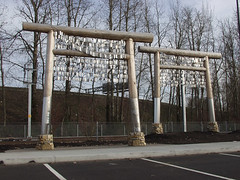Boring (very institutional) public art
art as art or art and meaning for art in transit stations? GGW discusses the proposed public art for stations on the Silver Line and at Farragut North station on the red line in "Metro reveals planned art for Silver Line stations."
This is an extract (slightly edited) of a blog entry from 2005, on public art on the Tri-Met Yellow Line in Portland, Oregon, speaking of challenging convention...
Tri-Met has guts, so does Portland (it's amazing to compare what Portland did in terms of public art on the Yellow Line vs. what most cities do and certainly the unwillingness to accept challenging art on the World Trade Center site in Manhattan). They committed to public art for the entire Yellow Line-Interstate Highway project. Each station has different public art themes.
I think the art at the Expo Center is perhaps the most powerful public art installation, one funded by a local government, that I have ever seen. The Expo Center was the site of a major Japanese-American relocation camp during World War II, when Japanese-Americans were interned on reservations out of beliefs that there were a threat to national security. The Expo Center served as a classification and embarkation station.

Valerie Otani addresses the theme of Japanese relocation during World War II at the site of the 1942 Portland Assembly Center. Traditional Japanese timber gates strung with metal "internee ID tags" mark station entrances.
Vintage news articles are etched in steel and wrapped around the gate legs. (The artist spoke to us on our tour.) And the headlines of the newspapers included in the work were viciously, virulently racist. These were not renegade newspapers, these were the daily newspapers of Portland, Oregon, reflecting the sentiment of the time.
What blows me away about this installation is that the Tri-Met transportation authority isn't gutless, that they spent public money on challenging public art. I just don't see that kind of willingness to challenge convention being present on the part of typical government agencies or elected officials in the DC region.
The second site is Vanport, which was an African-American community surrounding a steel plant. The land was below sea level, and protected by levees. When the levees broke in 1948, the community was wiped out, in a fashion similar to what happened in New Orleans during Hurricane Katrina. While only 15 people died, 20,000 people were left homeless. At this site, renditions of objects once owned by the people that lived there--these objects "bubble up" still--after rains and floods of this now wetland area--are built into the walls and benches.
Art for Metro Stations (boring...)

Image and caption from Greater Greater Washington. Proposed artwork for Metro stations. Left side, starting from top: Tysons East (Martin Donlin), Tysons Central 123 (Ray King), Farragut North (Jefre Manuel). Right side from top: Tysons West (Barbara Grygutis), Tysons Central 7 (David Dahlquist).
Check out this old publication from the Federal Transit Administration, Arts in Transit ... Making it Happen
and this: TriMet: About TriMet - Public Art Program. Tri-Met has also published guidebooks to the public art on the Interstate and Westside light rail lines.
Labels: cultural planning, public art, transit



0 Comments:
Post a Comment
<< Home